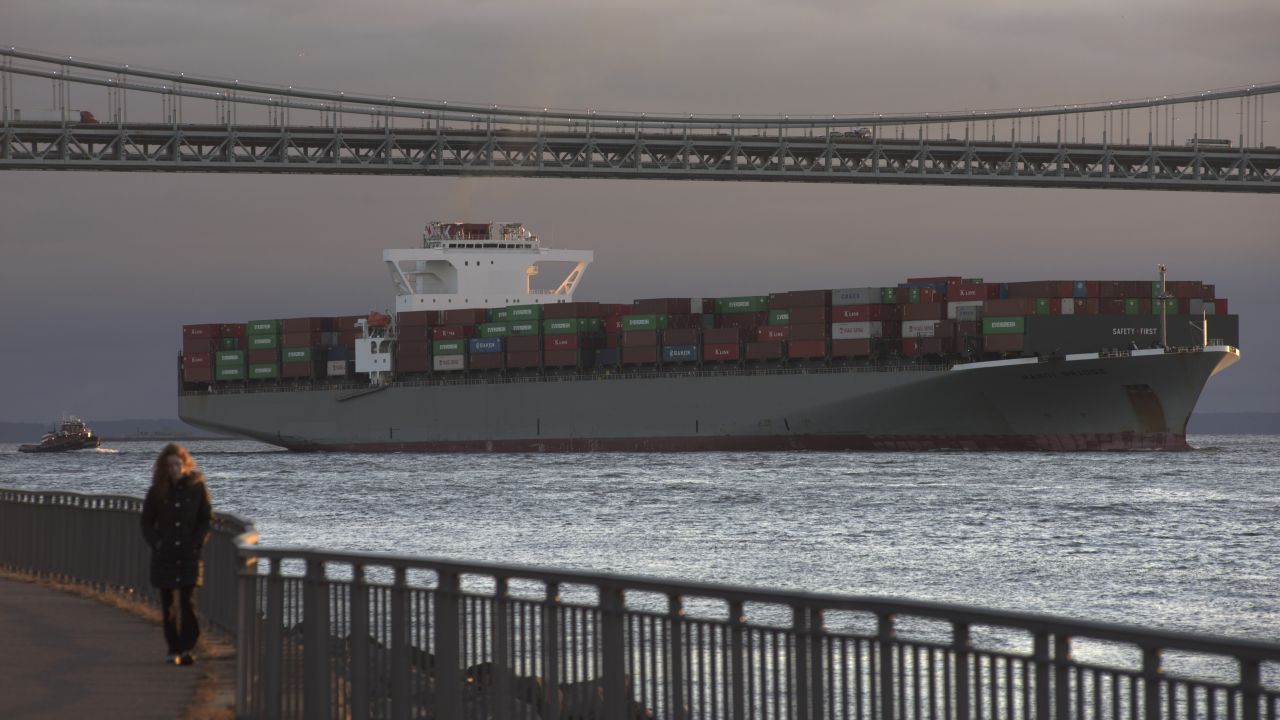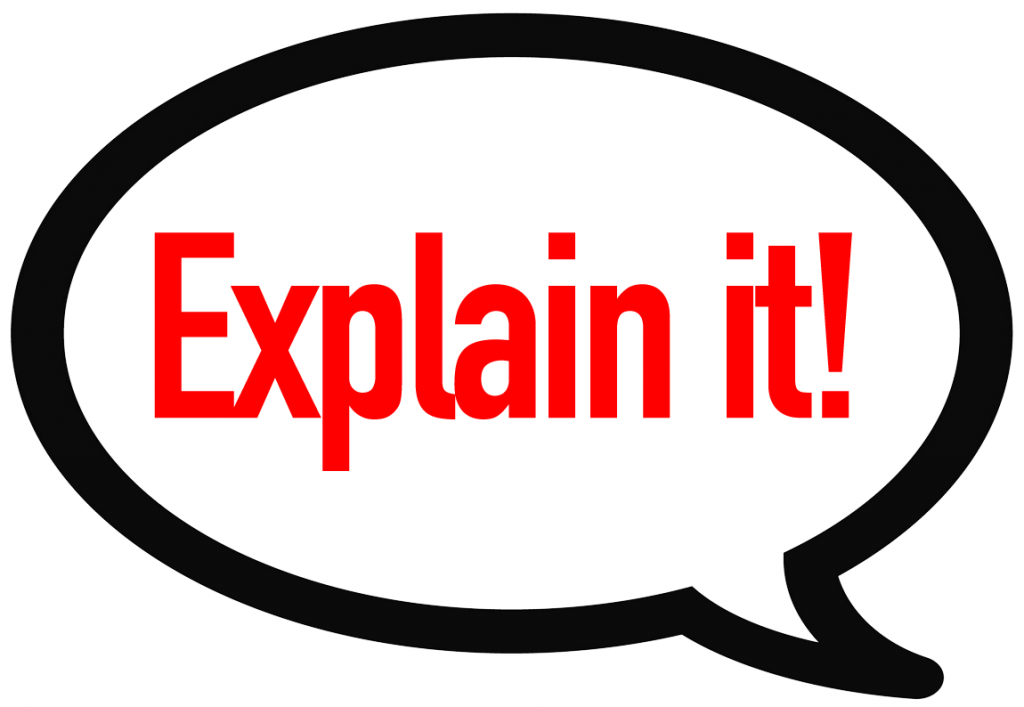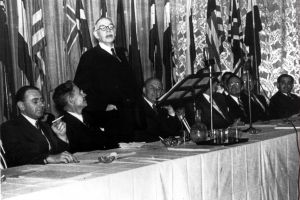
Container ships, like the one passing under the Verazano-Narrows Bridge on its way to the port of New York, bring inexpensive goods to the United States, but, critics say, at the cost of jobs and living standards here. (Neville Elder / Corbis)

Reader Jan Dillon, asks:
“What is the difference between fair trade and free trade? And about the Trans-Pacific Partnership (TPP): why are there special loopholes or add-ons favoring only certain businesses, like drug companies?”
Short answer: Fair traders are in favor of government policies that protect workers, farmers and the environment, and they will pay a premium for fair trade-certified goods. Free traders favor less government regulation and fewer trade barriers between countries and want the market to determine the price of goods in the hope of having the most choices at the lowest prices. The two terms are not opposites, but in the real world “free trade” comes with costs — and the TPP trade agreement that the Obama administration recently finished negotiating is, in the view of many critics, a shining example of that.
All trade is political. All trade is about power.
When you buy something — a car, clothes, coffee, computer, a hamburger, you name it — international trade agreements affect the price and determine who profits from it. Proponents of free trade say businesses should thrive or fail in an open market without government interference such as protections, tariffs or subsidies.
But trade is about much more than the price of your shoes. In practice, the parties who craft trade agreements are less interested in unfettered markets and far more interested in increasing corporate profits and pursuing international strategic goals. “There is no such thing as free trade,” says Barry Lynn, director of the Open Markets Program at the New America Foundation. “The idea that there is a self-regulating marketplace out there is fundamentally wrong, as opposed to a bunch of power relationships between large corporations and nation-states. Put simply, free trade is a myth.”
According to Lynn, the main reason people promote this “myth” is to push the idea that “government should not regulate the large corporations that run the marketplace. The two groups who push this argument in a coherent manner are the libertarian right and the neoliberal left.”
The fair trade movement
Fair trade is a social movement. Those who subscribe to it are willing to pay above-market prices for goods that come from small farmers and business people in developing countries in order to encourage living wages, safe working conditions, environmental sustainability and education. The goods are identified by labels from organizations like Fairtrade International, FLOCERT, The World Fair Trade Organization and many others that certify their producers share this mission. Companies like Cadbury and Starbucks have their own fair trade sourcing. Fair trade is a way of using the power of trade to pursue social and political goals, such as providing a fair wage to coffee growers in Guatemala.
A very brief history of US trade policy
The United States pursued something that looked more like a fair trade philosophy for much of the 50 years following World War II, says Lynn. “We used our trade power to ensure that American car workers got a fair wage; we also used our trade power to ensure that the Chinese or Japanese didn’t have control over vital semiconductor capacities. Or we used our power to ensure that no one had the ability to corner the market for copper.”
“Globalization 1.0,” as Lynn calls it, began just after World War II. As the world rebuilt, leaders negotiated the Bretton Woods agreement, which laid the ground rules for international trade in the latter half of the 20th century. With the agreement came new institutions, including the International Monetary Fund (IMF) and the World Bank.

Economist John Maynard Keynes speaks at the Bretton Woods Conference in 1944. (Photo by Universal History Archive/UIG via Getty Images)
Three years later, in 1947, 23 nations signed another agreement, the General Agreement on Tariffs and Trade (GATT). The people behind these agreements believed that by lowering tariffs and encouraging trade across borders, they could create more efficient industrial activity, Lynn says. Not every country has to manufacture cars, for example, if it can import them; that means each country can focus on developing its own unique industries. As countries traded lots of goods back and forth their economies improved; this deliberately engineered interdependence reduced the impulse to go to war. For 50 years global markets expanded and trade barriers toppled, while at home our government used regulation to fight monopolies.
So what happened?
What Lynn calls “Globalization 2.0.”
It arrived, he says, in the 1990s, along with a shift in philosophy in the US away from regulation. When then-President Bill Clinton ratified NAFTA in 1994 and signed up the US as a member of the World Trade Organization (WTO) in 1995, our global trade system was transformed. First, the WTO included many new countries without the same wage, environmental and worker health and safety standards as the US, including China, Brazil, India and the former Soviet Republics. Second, Lynn says, governments stepped back from the trade negotiating process, ceding power to large corporations and banks.
“Americans favor liberal trade,” says Lynn, “but what people don’t understand is the difference between liberal trade in which the government makes sure that the system continues to function for all the people, and a system in which the government abdicates that responsibility and turns all power and responsibility over to private actors who are out there to serve their own interests.”
The Trans-Pacific Partnership Agreement (TPP)
The TPP is billed as the largest trade deal in history. It includes 12 Pacific Rim countries — Australia, Brunei, Canada, Chile, Japan, Malaysia, Mexico, New Zealand, Peru, Singapore, the United States and Vietnam — and accounts for 40 percent of the world’s economy. Though the deal has drawn widespread opposition from politicians in both parties, including both 2016 major-party presidential nominees, the Obama administration signaled earlier this month that it will continue to push Congress to ratify the deal before the president leaves office on Jan. 20.
The TPP’s supporters tout it as a step forward for the environment and human rights. They cite the prohibitions against child labor and workplace safety rules, and protections against overfishing and wildlife trafficking. And when President Obama recently met with Singaporean Prime Minister Lee Loong, he emphasized that the deal would reduce tariffs. “It knocks out 18,000 tariffs that other countries place on American products and goods,” he said at a joint press conference.
But when researchers at Public Citizen looked up those tariffs, they found more than half the categories are of little concern to the United States, which does not export goods like shark fins, whale meat or ivory. In other cases, it will be 10 years before tariffs come down on many goods we do want to export — like beef and pork, to Japan.
The deal’s critics say that the TPP has little to do with “free trade” ideals, like tariff reduction, and was instead forged to satisfy corporate interests. It’s not difficult to understand how special protections for specific industries were hammered in: The deal, a complicated 2,000 pages long, was negotiated in secret by trade officials consulting with the hundreds of businessmen and lobbyists from private industry and trade groups who make up 85 percent of the president’s advisory committee on trade. Consumer, labor, environmental and public health advocates both in the US and abroad say they had little opportunity to comment on the deal during the five years it took to craft it.
Drug companies win, global public health loses
Big Pharma benefits because the TPP extends patents, copyrights and other monopoly protections to companies that want to profit for as long as possible. In an interview with Bill Moyers in 2013, economist Dean Baker explained there is nothing “free market” about these corporate safeguards against competition that will prevent millions of people around the world from getting cheaper generic medicines. “If this was really about trade,” he said, “we’d be going, ‘How can we bring those prices down?’
Firms that want to sue governments also benefit. The TPP creates an extra-judicial process known as an investor-state dispute settlement (ISDS). Foreign investors would be able to sue governments for compensation if they impose environmental, health and safety, and even labor regulations that result in lost profits to the company. These suits would be arbitrated by international tribunals that aren’t subject to US laws. There is no appeals process. Putting ISDS into such a sweeping deal, writes Sen. Elizabeth Warren (D-MA), “would tilt the playing field in the United States further in favor of big multinational corporations. Worse, it would undermine US sovereignty… America’s current trade policy makes it nearly impossible to enforce rules that protect hard-working families, but very easy to enforce rules that favor multinational corporations.”
Political positioning
During the presidential primary, opposition to the TPP was a cornerstone of Sen. Bernie Sanders’ campaign; he blasted it for costing America jobs, undermining US environmental regulation and increasing the cost of prescription drugs. Sanders’ and Warren’s frequent and forceful attacks on the TPP pressured Hillary Clinton to follow suit, despite having supported the deal as secretary of state.
Standing before workers at a manufacturing plant in Michigan this month, Clinton said, “I will stop any trade deal that kills jobs or holds down wages, including the Trans-Pacific Partnership. I oppose it now, I’ll oppose it after the election and I’ll oppose it as president.” It is, in fact, a position that puts her in rare agreement with Donald Trump, who also opposes the TPP denouncing it as “a job killer” and a “disaster.”




